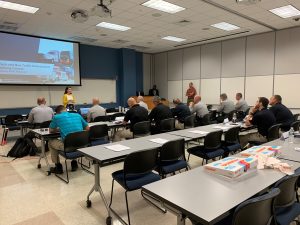Policing in the United States has changed over time, as has U.S. society. Various criminological schools—the pre-classical school, classical school, positivist school, and neo-classical school—have all attempted to explain criminal behaviors and how to mitigate the effect of criminal acts on society, but none have provided significant answers. In today’s society, more value is being placed on equity, inclusion, and diversity, including in law enforcement. Having more transparency and accountability in policing directly impacts the community-police relationship and can help mitigate criminal activity and reduce recidivism.
When discussed, equity, inclusion, and diversity are not mutually exclusive; they are integral to success. Equity speaks to fairness and treatment to include equality of opportunity, while inclusion prompts an environment conducive to feedback openness. Diversity is concerned with representation and perspectives; when an organization establishes equity, it demonstrates that it values inclusion and diversity. Doing so is essential to law enforcement operations and their effectiveness within the community.
A Matter of Ethics
Ethical standards play a significant role in law enforcement and policing. As practitioners, officers are faced with unique ethical situations daily and a continued understanding of their moral obligations and duties is warranted.1
Individuals in the criminal justice system exercise both power and authority over others and, in certain situations, are given the authority to use force and coercion. The nature of policing continues to be viewed by law enforcement officers as a struggle between crime fighter and being a social peacekeeper.2
A person’s perceptions of equity, inclusion, and diversity directly affect ethical decision making. If an individual does not value equity, inclusion, and diversity, their judgments will not be aligned to provide fair treatment and the broad representation and perspectives of society.
Policing is the defense of communities, the duty of making sure neighborhoods are safe. All individuals have the right to be protected, and individuals committing crimes need to be brought to justice. Equity, inclusion, and diversity are essential to ensuring protections and resolving justice for all are achieved and are required for productive agencies and communities.

The challenges that law enforcement faces today are significant and varied, and they are dependent upon the level (state, local, tribal, and federal) in which the officers are serving. Nonetheless, accountability, training (use of force), and other organizational issues (such as implicit bias and profiling) are applicable every day in law enforcement organizations of all levels. Therefore, the need for transformation continues, as well as the need for changes in policies, accountability, training, culture, and practice. Leadership and transparency with the public are crucial to reform efforts. Leadership must be transparent within the community and in concert with organizing and building the community to have a significant impact.
Recommendations to Implement Change
There are numerous and varied strategies for implementing equity, inclusion, and diversity within an organization. Presented herein are seven recommended evidence-based strategies to assist agencies and personnel. In this instance, “evidence-based” is defined as “any concept or strategy that is derived from or informed by objective evidence—most commonly, educational research or metrics of school, teacher, and student performance.”3 The following list of universal evidence-based strategies and explanations can be adopted to local, county, state, federal, and tribal agencies.
Conduct an Internal Climate Assessment
Perform an internal climate assessment survey of law enforcement officers from patrol to middle-level management (sergeants, detectives, lead investigators, etc.) to determine the status of agency and organizational climate.
This survey should measure several dimensions and should be administered annually. Internal surveys should be categorized and pose questions that measure officers’ perceptions, knowledge, and understanding of several areas to include overall job satisfaction; overall work climate; perceptions on existing leadership; perceptions on training opportunities; perceptions on community policing; knowledge of policing philosophies; police roles; current understanding of equity, inclusion, and diversity in law enforcement; knowledge of internal policies and procedures; understanding of the use-of-force model; de-escalation training assessment; and so forth. It is best to use a Likert scale to measure responses; however, personnel should also have an area on the survey to include text-based responses, recommendations, and comments.
Conduct Audits
Senior leadership should perform frequent unscheduled organizational internal audits on police reports, incident reports, use-of-force reports, citizens’ complaints, personnel files, social media, and other documentation to ensure department compliance with equity, inclusion, and diversity training, standards, policies, and procedures.
Regular training should take place in the areas of equity, inclusion, and diversity for all department personnel. To measure compliance, it is imperative to conduct unplanned and unscheduled audits to determine agency and personnel efficiency. These types of audits allow senior leadership to understand if improved policies and procedures are being followed from traffic patrol to middle-level managerial positions. It also allows leadership to make changes rapidly to ensure that the areas needing improvement are addressed immediately.
Review Use-of-Force Models
Evaluate, revise, improve, and update existing department use-of-force models. There have been many recent incidents that have prompted local, county, state, federal, and tribal agencies to evaluate all internal policies and procedures to include use-of-force models and use-of-force training for personnel. Use-of-force models should be evaluated frequently to ensure that officers are receiving the best training possible. This training should take place at the police academy for new officers and via in-person annual training for seasoned law enforcement officers. As an example, chokeholds have been removed from many departments use-of-force models due to possible injury and death of the suspect. As a solution, personnel are now being trained in new apprehension methods to prevent injury and death.
Ensuring the use-of-force models are updated further communicates to the public that law enforcement agencies are listening and making changes as needed to better protect and serve the public. If an incident has occurred and the existing use-of-force model did not work, the model must be revisited and reevaluated. The latest use-of-force models should be pictorially presented and posted and published in various areas throughout the department.
Update De-escalation Training
Evaluate, revise, improve, and update existing department de-escalation training policies and procedures. Law enforcement officers and personnel interacting with the public should receive frequent de-escalation training from trainers within the agency. Law enforcement officers are often confronted with unique, impromptu, and difficult situations that typically require immediate response. Officers must be able to de-escalate incidents at the lowest level of conflict possible. This is done by using proven scientific-based strategies to defuse situations and circumstances that could lead to violent encounters.
 Performing a climate assessment survey will allow senior leadership to quantitatively interpret the understanding of de-escalation training and standards within their organization. Officers should have a general knowledge of de-escalation and be able to clearly communicate protocols as a general part of their daily duties. New and updated de-escalation policies should include risk assessment strategies that ensure effective decision-making is taking place by officers and personnel. Additionally, de-escalation training should include role-play situations and tabletop exercises. These activities allow personnel to act out scenarios while allowing an accurate assessment of response and determination if proper de-escalation practices took place.
Performing a climate assessment survey will allow senior leadership to quantitatively interpret the understanding of de-escalation training and standards within their organization. Officers should have a general knowledge of de-escalation and be able to clearly communicate protocols as a general part of their daily duties. New and updated de-escalation policies should include risk assessment strategies that ensure effective decision-making is taking place by officers and personnel. Additionally, de-escalation training should include role-play situations and tabletop exercises. These activities allow personnel to act out scenarios while allowing an accurate assessment of response and determination if proper de-escalation practices took place.
Enforce a Zero-Tolerance Policy
Ensure there is a zero-tolerance policy in place for law enforcement officers and personnel who do not follow updated policies, procedures, and regulations. Senior leadership must ensure that all officers and personnel are held accountable for their actions if protocol is not followed. Holding personnel accountable for their actions communicates to the department and to the public that all individuals within an agency are held to the highest of standards. It also ensures that disciplinary policies are equitable across the organization.
Properly Train Leadership
Ensure senior leadership are properly trained on equity, inclusion, and diversity and that the updated policies, procedures, and training are properly disseminated and communicated to all levels of the agency. In today’s era, it is not uncommon for local, county, state, federal, and tribal law enforcement agencies to partner with external consultants and organizations to obtain up-to-date training on equity, inclusion, and diversity. Partnering with external consultants and organizations ensures unbiased implementation of policies, procedures, regulations, use-of-force models, de-escalation training, and other topics.
Many consulting organizations utilize a train-the-trainer teaching methodology. This ensures that the training can be administered by internal and external personnel. It also allows trainers to assist in evaluating, revising, improving, and updating existing department policies and procedures related to equity, inclusion, and diversity on a frequent basis.
Enhance Officer Training
Enhance diversity, inclusion, and equity training media for law enforcement officers and agencies. Training should be able to be completed in-person, via webinar, via online learning management system, in a self-paced format, and so forth. If law enforcement agencies offer training in a variety of platforms, it will ensure that all personnel are trained and retrained as needed. Further, there also needs to be a post-assessment of the training to ensure that staff have retained and comprehended the subject matter on inclusion, equity, and diversity.
Conclusion
For law enforcement reform to take place, departments and leadership must review measurable evidence-based strategies that have been proven to work in other local, county, state, federal, and tribal agencies. Further, these strategies must ensure community transparency is taking place and accountability standards are being enforced by law enforcement leadership at all levels. This ensures that public periodic reviews can take place on department understanding and training on equity, inclusion, and diversity.
Notes:
1Charles Russo, “Ethics in Law Enforcement and Intelligence,” College of Safety & Emergency Services Academic Journal, August 5, 2020.
2Charles Russo, Influence of Individual and Sociocultural Characteristics on Ethical Decision-Making among Students (PhD dissertation, Capella University, 2018), 4.
3The Glossary of Education Reform, s.v. “Evidence-Based.”
Please cite as
Charles Russo and Thomas Rzemyk, “Finding Equity, Inclusion, and Diversity in Policing,” Police Chief Online, August 4, 2021.



